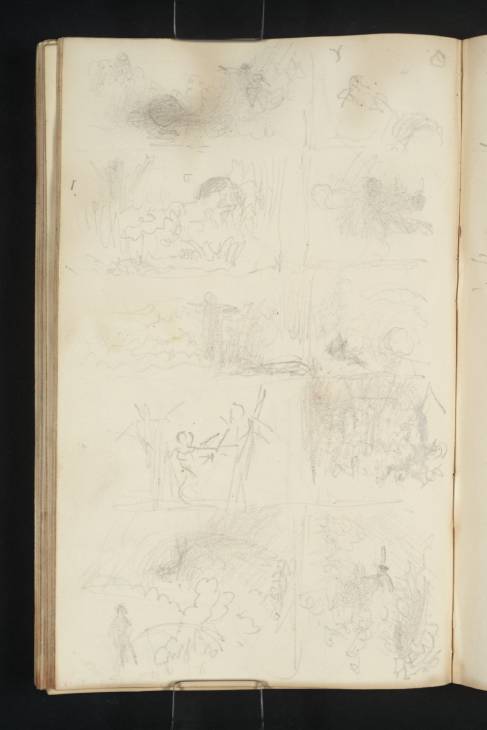J.M.W. Turner
>
1830-35 Annual tourist
>
Scotland 1834
>
Edinburgh Sketchbook
>
Artwork
Joseph Mallord William Turner Ten Designs for Vignettes c.1834
Joseph Mallord William Turner,
Ten Designs for Vignettes
c.1834
Joseph Mallord William Turner 1775–1851
Folio 28 Verso:
Ten Designs for Vignettes circa 1834
D26149
Turner Bequest CCLXVIII 28a
Turner Bequest CCLXVIII 28a
Pencil on white wove paper, 181 x 111 mm
Accepted by the nation as part of the Turner Bequest 1856
References
1909
A.J. Finberg, A Complete Inventory of the Drawings of the Turner Bequest, London 1909, vol.II, p.861, CCLXVIII 28a, as ‘Ten designs for vignettes (?)’.
Finberg suggested that the ten sketches on this page, and four more on folio 29 (D26150), may be designs for vignettes.1 Although none have a distinctly vignette format, and neither have they been linked directly to any completed vignettes by Turner, the suggestion is persuasive. None of the designs on the present page have a composition that strongly relates to the rectangular pencil borders that surround them, while some have a composition with a strong central focus which is typical of Turner’s vignette style, such as those at the top-left and at bottom-right corners. While none of the subjects are recognisable, the recurring themes of figures in the sky, the sun and clouds are reminiscent of some of the vignette illustrations to Roger’s Poems, Milton’s Poetical Works, Campbell’s Poetical Works, and Thomas Moore’s Epicurean. Assuming that these sketches were made at the same time, or shortly after the Scottish sketches in this book (September–October 1834), they may be related to the preparation of vignettes to Milton’s Poetical Works.
The designs will be discussed from left to right and top to bottom, and are numbered below accordingly, so that the top left sketch is ‘1’, and the bottom-right sketch is ‘10’.
Sketch 1 at the top left of the page is centred on a large sun, which hovers low over water and is surrounded by clouds. A figure floats at the right, its right arm stretching out towards the sun. The composition as a whole does not resemble any finished vignette, but the spirit-figure is reminiscent of various figures in vignettes such as The Fall of the Rebel Angels, circa 1834 (Tate T06286). Designs 2, 5 and 7 also contain figures of this type.
Sketch 2 depicts a figure floating above clouds or waves with what may be a crescent moon at the top left and a sun at the top right.
Sketch 3, which may be labelled ‘1’ by Turner, appears to depict a swirling tempestuous sea. The waves meet the clouds at the left and right of the image, creating a strong vortex composition appropriate for a vignette format. The subject and composition are reminiscent of The Death Boat of Heligoland, 1837 (Tate) for Campbell’s Poetical Works.
A mass of dark and light cloud above water is depicted in sketch 4, though no other details are discernable.
Sketch 5 shows a robed figure standing with its arms raised in the sea of clouds. The figure’s pose is reminiscent of the dark figure in Turner’s watercolour Vignette Study for Moore’s ‘The Epicurean’; The Grotto of the Anchoret, circa 1837–8 (Tate D27643; Turner Bequest CCLXXX 126), though the setting does not match.
Sketch 6 is hard to make out but may again depict masses of swirling cloud. A dark shape at the lower left is suggestive of a seated figure or figures seen from above.
Three figures are depicted in sketch 7. At the centre a female is being led, apparently against her will judging by her straining pose, by a male figure on either side. The left figure is suggestive of a bishop with his robe and mitre-like hat, while the figure on the right carries a staff or cross.
The figure at the right of sketch 8 may also be carrying something like a cross, a standard or a scythe. He is reminiscent of the man carrying a scythe in the right of A Village Evening, for Rogers’s ‘Poems’, circa 1826–36 (Tate D27685; Turner Bequest CCLXXX 168).
Sketch 9 depicts a figure, perhaps standing on a mountain top, looking out over clouds to a dark sky. To the right is a semi-circle which appears to be inscribed ‘Cruf[...]’.
The final sketch, number 10 at the bottom right of the page, depicts a cliff-top tower surrounded by clouds or mist. Such towers are common in Turner’s watercolours of the Rhine valley, and one appears in the background of St Pierre’s Cottage, for Rogers’s ‘Poems’, circa 1831–2 (Tate D27700; Turner Bequest CCLXXX 183) (which predates this sketch), in Rolandseck, 1837 (Tate T04779) for Campbell’s Poetical Works, in The Dead Eagle – Oran, 1837 (Tate T04785), and in the Vignette Study for Moore’s ‘The Epicurean’; Pharos (The Scarlet Tower), circa 1837–8 (Tate D27594; Turner Bequest CCLXXX 77).
Thomas Ardill
January 2011
How to cite
Thomas Ardill, ‘Ten Designs for Vignettes c.1834 by Joseph Mallord William Turner’, catalogue entry, January 2011, in David Blayney Brown (ed.), J.M.W. Turner: Sketchbooks, Drawings and Watercolours, Tate Research Publication, December 2012, https://www

